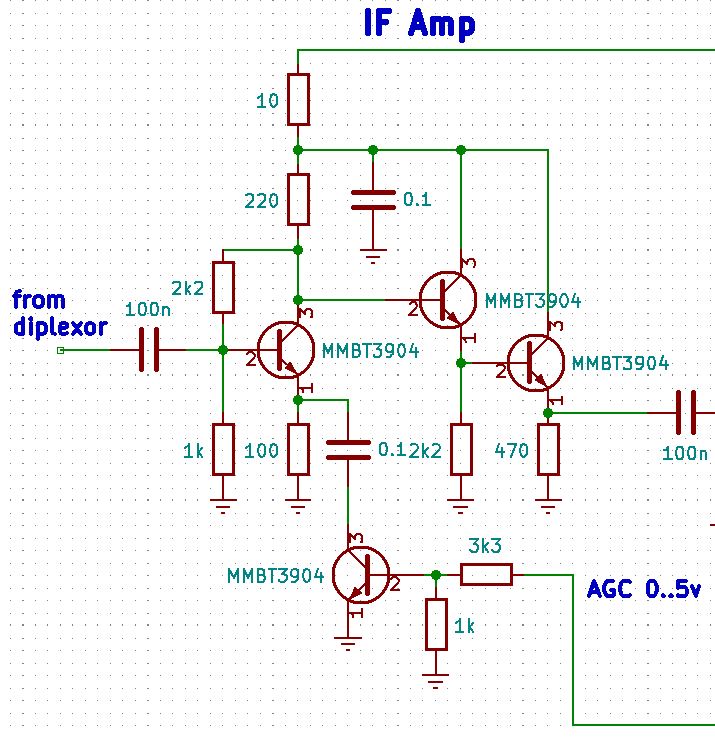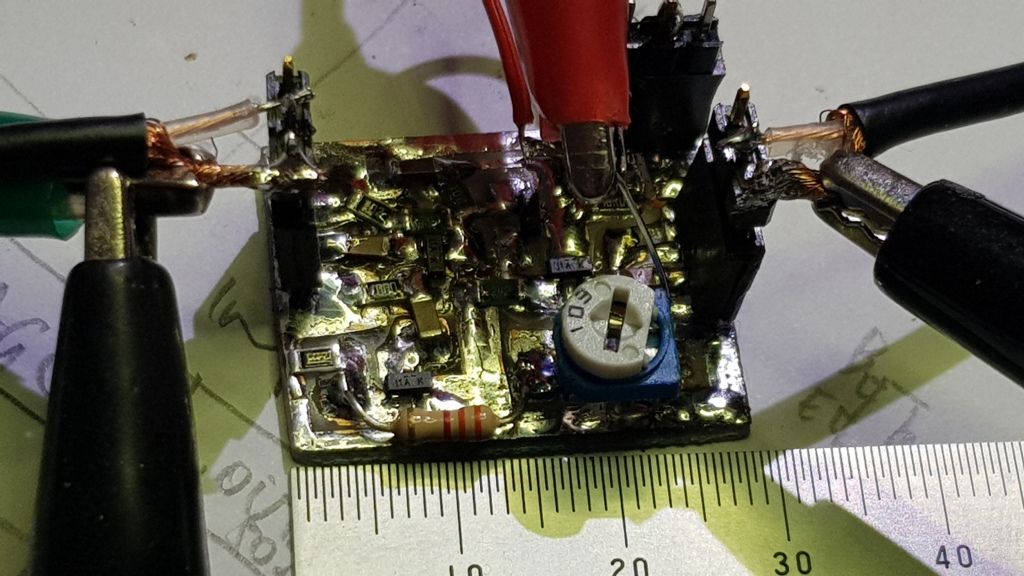For AGC controlled IF stages in receivers I have often chosen a 2 or 3 stage dual gate MOSFET strip, or a cascode arrangement with a bipolar and JFET pair. These work well, have more than enough overall gain, and provide good AGC-controlled gain range. I’ve also built a BiTX style transceiver (Andy G6LBQ’s design) with two Termination Insensitive Amplifier blocks. TIAs exhibit stable input and output impedance regardless of load, and work symmetrically (for receive and transmit) but are fixed gain. My BiTx receiver worked acceptably on 40m but was underpowered on 20m. Increasing the gain to make it more lively on 20m would have made it over-powered on 40m. You don’t have this problem when you have an AGC controlled IF.
So when I saw a mod by George VK4AMG to increase a friend’s uBiTx receiver gain on 28MHz I was very interested.

The uBitx transceiver uses Termination Insensitive Amplifiers in the high and low intermediate frequencies. The Termination Insensitive Amplifier is a design element of great pedigree. It originated with some Plessey radio transceiver designs in the 60s and was popularized for amateur use by Wes Hayward W7ZOI and Bob Kopski K3NHI.
On the uBitx page, designer Ashar Farhan VU2ESE writes … “We used the excellent termination insensitive amplifiers (TIA) developed by Wes Hayward and Bob Kopski (read about them on www.w7zoi.net). These amplifiers work without transformers and they provide excellent termination on both sides. This is a key requirement for bidirectional transceivers like the µBITX . We use four blocks of these amplifiers in this transceiver. The amplifier block has a gain of 16 db and OIP3 of about +20 dbm as measured inside the µBITX .”
So I prototyped the uBitx TIA with George’s mod, a 2N3904 in place of the 10 ohm emitter resistor. I first drew it in kicad. It’s easy to see how the additional transistor replaces the usual low value resistor in the emitter degeration.


Built on a scrap of etched PCB using surface mount parts.

I measured 14dB of total gain this block, not the 25 to 30dB I expected, with 14dB AGC action. Here are some measurements:
The amp stage is flat to about 15MHz, that’s good. And at 8V of AGC the block delivers 19dB of gain which is about spot on for a typical receiver, assuming you will use two or three such blocks. I dropped the 3k3 resistor in series with the controlling 2n3904 base to 1k and measured nearly 20dB of gain.
Prototype 4MHz IF strip
Next, I built two of these gain controlled TIA blocks in an IF strip for a CW superhet receiver. A narrow crystal filter provides the intended CW receiver bandwidth, adding 3 to 5 dB attenuation in its passband. The bench test is shown in the video — 50dB of total gain with 30dB of AGC range, not as much as can be achieved with MOSFETs, or as much as George measured, but still a useful range.
Discussion with Bill and Pete
Next, I shared a knock-up video with Bill and Pete from Soldersmoke, as they have both been strong promoters of the TIA in their projects and through the podcast and blog. Bill wondered what other side effects of varying Rd might be, and that sent me back to Wes and Bob’s 2009 paper. Another likely consequence is that dynamically changing Rd is likely to change the input impedance away from the desired 50 ohms. So the AGC controlled TIA is not really a TIA anymore.
Conclusion
Is this a useful TIA hack? Certainly the gain swing is useful. The impact of having the TIA gain block’s input impedance swinging around in sympathy with signal strength does not sound ideal, but probably depends on what each block is interfacing with. In my prototype receiver, the second TIA block interfaces to the output side of the 4MHz crystal filter via a matching transformer. An impedance mismatch here will result in some power loss. The first TIA interfaces with the output of a ‘strong’ 2N5179 post-mixer IF amplifier stage, which is via a 50 ohm pi-attenuator.
I you find this TIA ‘hack’ interesting and maybe give it a try. Please let me know what you think of it in a video comment.
Thanks to George VK4AMG for sharing it on VK Homebrew on Facebook and for subsequent email correspondence.

Thanks Paul. Yea, this might work, if the input impedance on that stage is not a big deal. But in a bilateral rig, on either side of the crystal filter use of a TIA this circuit will affect input impedance, and that will affect filter shape, especially ripple. (one way or the other!)
I have shared your post with someone DEEPLY familiar with TIAs. Stay tuned. 73 Bill
LikeLike
Thanks for commenting Bill. I did not see this blog comment until the day after that TIA guy’s email appeared. Thanks again. Wes has provided a DEEPLY interesting response, placing a gain controllable stage inside the TIA block. I’m going to prototype it and repeat the gain and AGC range test. 73 Paul.
LikeLike
Paul, did You measure and plot the function of the gain vs. AGC voltage? As in the discussuion with Pete and Billl, my first thought was, when I studied Your schematic, that most likely the input impedance will vary within the AGC range.
LikeLike
Hello Henning, no I didn’t plot gain vs AGC, that would be worthwhile. The YT and blog discussion on this topic has been excellent, I now understand the impedance/gain/linearity relationship much better. The impact of having the input Z swing with the AGC is more or less a problem depending on where the TIA gain block is placed. All good fun! 73 Paul.
LikeLike
Very interesting Paul, I have been pondering ways to add AGC to the TIA amps and was thinking about proceeding them with PIN diode attenuators. It would be interesting to try the extra 2N3904 transistor method and possibly add some kind of offset to the individual TIA stages in the receive chain to make the AGC sequential for maximum signal to noise ratio.
LikeLiked by 1 person
Hi Andy,
Good to hear from you. This thread has moved on. Bill Meara N2CQR shared my video with Wes Hayward W7ZOI no less. Wes ran with it and came up with a new configuration of TIA gain stage, with a Cascode bipolar/JFET, then the usual common emitter pair. Wes then prototyped and tested it, and even wrote a very fine paper on the TIA-AGC.
The Soldersmoke post is here:
http://soldersmoke.blogspot.com/2021/08/adding-automatic-gain-control-to.html
It has a link to Wes’ article.
I am keen to prototype an AGC-TIA, and put it on test, when I do, I’ll make a followup video!
BTW the receiver in the above video uses an audio stage built to your Irwell schematic. The T/R switching with a 4066 is silent. That project is progressing.
73 Paul VK3HN.
LikeLike
Great stuff Paul likewise its nice to hear from you with your reply and the further information that I will follow up. Glad you tried the 4066 switch circuit with success, my Irwell project is ongoing and I am making progress albeit a little slow as I struggle to find time to devote to the project.
Best regards
Andy (G6LBQ)
LikeLiked by 1 person
Andy, I’m following Irwell with great interest, all your design choices look thoroughly contemporary and I will certainly build more bits of it in the future, or even an entire transceiver one day.
73 Paul VK3HN.
LikeLike
I feel a PIN diode from the the collector to ground of the first stage of TIA amp might result in a larger AGC control range.
73
Rahul VU3WJM
LikeLike
Hi Rahul, it is worth a try. Recognizing that the amplifier impedance will change.
LikeLike
Thanks for sharing the information about the AGC for a termination insensitive amplifier, I think your blog is very helpful for lot of people.
LikeLike
Hi there, thanks for commenting, appreciated. I see you have a very impressive looking ham radio store. All the best with your projects! Paul VK3HN.
LikeLike